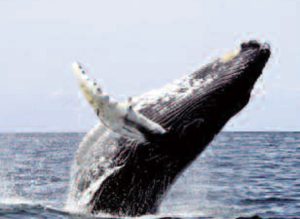SCORES & OUTDOORS: A whale of a project for a Unity College senior
 SCORES & OUTDOORS
SCORES & OUTDOORS
by Roland D. Hallee
Every summer, my wife and I head out to Boothbay Harbor, catch the boat and head out to Cabbage Island for one of their famous, old-fashioned, New England clam and lobster bakes. While waiting to board the ship, in the center of the village, we see all kinds of advertisements for whale watching excursions.
“I wonder what that would be like,” I think, and then my attention goes towards those whales and why do people spend the time – and the money – to watch them? Do the tides affect their travels? This is what I found out.

baleen whale
According to a study made by Laurel Sullivan, a member of the class of 2018 at Unity College, in a press release from Micky Bedell, Associate Director, Media Relations, whale watching, for some, may bring to mind school field trips or coastal vacations. Fanny packs and binoculars. Long stretches of ocean and searching eyes, with the hope that maybe, just maybe, one of the largest animals on earth will appear in the waters below.
But for Sullivan whale watching is both all of these things and none of these things at once. Whale watching isn’t just a pastime for Laurel — it’s conservation. Science.
“There’s nothing like it. It’s why I do what I do,” she says emphatically, describing the inherent awe in the arch of a whale’s massive body, stretching as high as a building into the sky, before it crashes gracefully back down into the water. “I’m at my happiest when I’m watching whales and when I’m on a boat in the middle of the ocean.”
During an internship with the New England Aquarium the summer between her sophomore and junior year, Laurel witnessed breaches, flipper slapping and lob tailing day after day on whale watching boats. She used these graceful, sometimes playful activities to educate visitors on the beautiful marine mammals in front of them, while also collecting and transcribing data of their identification, location and behavior. Laurel spent hours on whale watching boats. She loved every minute of it.
So, with support from advisors Dean Pieter deHart and Associate Professor Tom Mullin, Laurel has spent the last few months comparing eight years of baleen whale sighting data in the Bay of Fundy with the underwater depth of the bay at different points in the tide cycle. Using GIS, Laurel overlaid these datasets onto bathymetric maps that will eventually allow her to make conclusions on whether whale location in the Bay of Fundy is related to the tides.
Besides the standard scientific paper on her findings, those conclusions will lead Laurel to a unique end goal: suggested guidelines and interpretive materials for local whale watching companies in the Bay of Fundy. Inspired by her time educating whale watchers, Laurel wanted to be able to communicate her findings to a variety of audiences. Maps, she says, are just more visual. They allow people to understand concepts without necessarily understanding the complex math behind them. And making solid, helpful, scientific suggestions for whale watching companies in the Bay of Fundy could have “a real effect on those businesses,” according to Dr. deHart.
Whale watching is not just a fun pastime — the tourism it brings presents an economic opportunity for many communities around the world. And there’s no better opportunity than in the midst of wonder in seeing a whale to bring the value of their existence to the forefront, according to Laurel.
“People may see whales and think it’s cool, but the guides have to make that important for them. Why are the whales here? Why are they important?” Laurel says. “The Bay of Fundy is a feeding ground, so it’s especially important in this area to help people understand and care about conservation.”
This past summer, she spent three days whale watching with companies on the Bay of Fundy in Saint Andrews, New Brunswick, Lubec, Maine, and Campobello Island, New Brunswick with funding from Unity College’s Student Academic Engagement Fund and Holt Scholarship.
“Going into the field to collect data is an important part of the process. It lets you connect with nature; connect with the whales and local companies; and get out of the lab and out from behind a computer screen. It’s important that Laurel had that experience,” Dr. deHart said.
“I have more pictures of whales on my phone than I have pictures of me,” she says with a laugh. “All my friends give me a hard time because I’m definitely the whale kid on campus. I’m always like, ‘So with the whales…’ and they’re like, ‘Please stop.’
“I’m having a blast. This is not what I ever expected to be doing. This is so much better than just writing a paper.”
Responsible journalism is hard work!
It is also expensive!
If you enjoy reading The Town Line and the good news we bring you each week, would you consider a donation to help us continue the work we’re doing?
The Town Line is a 501(c)(3) nonprofit private foundation, and all donations are tax deductible under the Internal Revenue Service code.
To help, please visit our online donation page or mail a check payable to The Town Line, PO Box 89, South China, ME 04358. Your contribution is appreciated!


Leave a Reply
Want to join the discussion?Feel free to contribute!